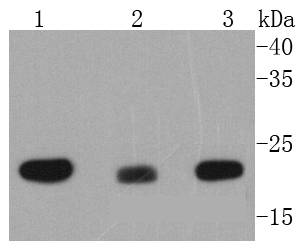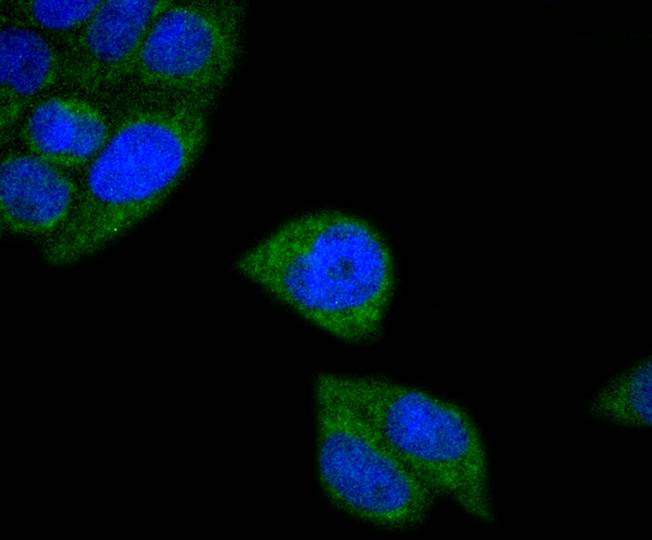Product Name :
MTCO2 polyclonal antibody Background :
Cytochrome c oxidase subunit II (COX2), also designated COII, MTCO2 or oxidative phosphorylation (OxPhos) complex IV, subunit II, is one of three mitochondrial DNA (mtDNA) encoded subunits (MTCO1-3) of respiratory complex IV. Cytochrome c oxidase is a hetero-oligomeric enzyme composed of 13 subunits localized to the mitochondrial inner membrane and is the terminal enzyme complex of the electron transport chain. Complex IV catalyzes the reduction of molecular oxygen to water. The energy released is used to transport protons across the mitochondrial inner membrane. The resulting electrochemical gradient is necessary for the synthesis of ATP. Complex IV contains 13 polypeptides; COX1, COX2 and COX3 (MTCO1-3) make up the catalytic core and are encoded by mtDNA while subunits IV, Va, Vb, VIa, VIb, VIc, VIIa, VIIb, VIIc and VIII are nuclear-encoded. Defects in COX2 are associated with tumor formation. Product :
Rabbit IgG, 1mg/ml in PBS with 0.02% sodium azide, 50% glycerol, pH7.2 Storage&Stability :
Store at +4°C after thawing. Aliquot store at -20°C or -80°C. Avoid repeated freeze / thaw cycles. Specificity :
MTCO2 polyclonal antibody detects endogenous levels of MTCO2 protein. Immunogen :
recombinant protein Conjugate :
Unconjugated Modification :
Unmodification
MTCO2 polyclonal antibody Background :
Cytochrome c oxidase subunit II (COX2), also designated COII, MTCO2 or oxidative phosphorylation (OxPhos) complex IV, subunit II, is one of three mitochondrial DNA (mtDNA) encoded subunits (MTCO1-3) of respiratory complex IV. Cytochrome c oxidase is a hetero-oligomeric enzyme composed of 13 subunits localized to the mitochondrial inner membrane and is the terminal enzyme complex of the electron transport chain. Complex IV catalyzes the reduction of molecular oxygen to water. The energy released is used to transport protons across the mitochondrial inner membrane. The resulting electrochemical gradient is necessary for the synthesis of ATP. Complex IV contains 13 polypeptides; COX1, COX2 and COX3 (MTCO1-3) make up the catalytic core and are encoded by mtDNA while subunits IV, Va, Vb, VIa, VIb, VIc, VIIa, VIIb, VIIc and VIII are nuclear-encoded. Defects in COX2 are associated with tumor formation. Product :
Rabbit IgG, 1mg/ml in PBS with 0.02% sodium azide, 50% glycerol, pH7.2 Storage&Stability :
Store at +4°C after thawing. Aliquot store at -20°C or -80°C. Avoid repeated freeze / thaw cycles. Specificity :
MTCO2 polyclonal antibody detects endogenous levels of MTCO2 protein. Immunogen :
recombinant protein Conjugate :
Unconjugated Modification :
Unmodification
-
 Western blot analysis of MTCO2 on different lysates using anti-MTCO2 antibody at 1/1,000 dilution. Positive control: Lane 1: MCF-7 Lane 2: THP-1 Lane 3: Hela
Western blot analysis of MTCO2 on different lysates using anti-MTCO2 antibody at 1/1,000 dilution. Positive control: Lane 1: MCF-7 Lane 2: THP-1 Lane 3: Hela -
 ICC staining MTCO2 in Hela cells (green). The nuclear counter stain is DAPI (blue). Cells were fixed in paraformaldehyde, permeabilised with 0.25% Triton X100/PBS.
ICC staining MTCO2 in Hela cells (green). The nuclear counter stain is DAPI (blue). Cells were fixed in paraformaldehyde, permeabilised with 0.25% Triton X100/PBS.
Bioworld Biotech only provide peptides for our antibodies and do not provide additional peptide customization services.
Price/Size :
USD 368/1mg/vial
Tips:
For phospho antibody, we provide phospho peptide(0.5mg) and non-phospho peptide(0.5mg).Describe :
Blocking peptides are peptides that bind specifically to the target antibody and block antibody binding. These peptide usually contains the epitope recognized by the antibody. Antibodies bound to the blocking peptide no longer bind to the epitope on the target protein. This mechanism is useful when non-specific binding is an issue, for example, in Western blotting (WB) and Immunohistochemistry (IHC). By comparing the staining from the blocked antibody versus the antibody alone, one can see which staining is specific; Specific binding will be absent from the western blot or IHC performed with the neutralized antibody.Formula:
Synthetic peptide was lyophilized with 100% acetonitrile and is supplied as a powder. Reconstitute with 0.1 ml DI water for a final concentration of 10 mg/ml.The purity is >90%,tested by HPLC and MS.
Storage:
The freeze-dried powder is more stable. For short time at 2-8°C. For long term storage store at -20°C.
Note :
This product is for research use only (RUO only). Not for use in diagnostic or therapeutic procedures.
 MTCO2 polyclonal antibody
MTCO2 polyclonal antibody  Datasheet
Datasheet COA
COA MSDS
MSDS SHIP
SHIP